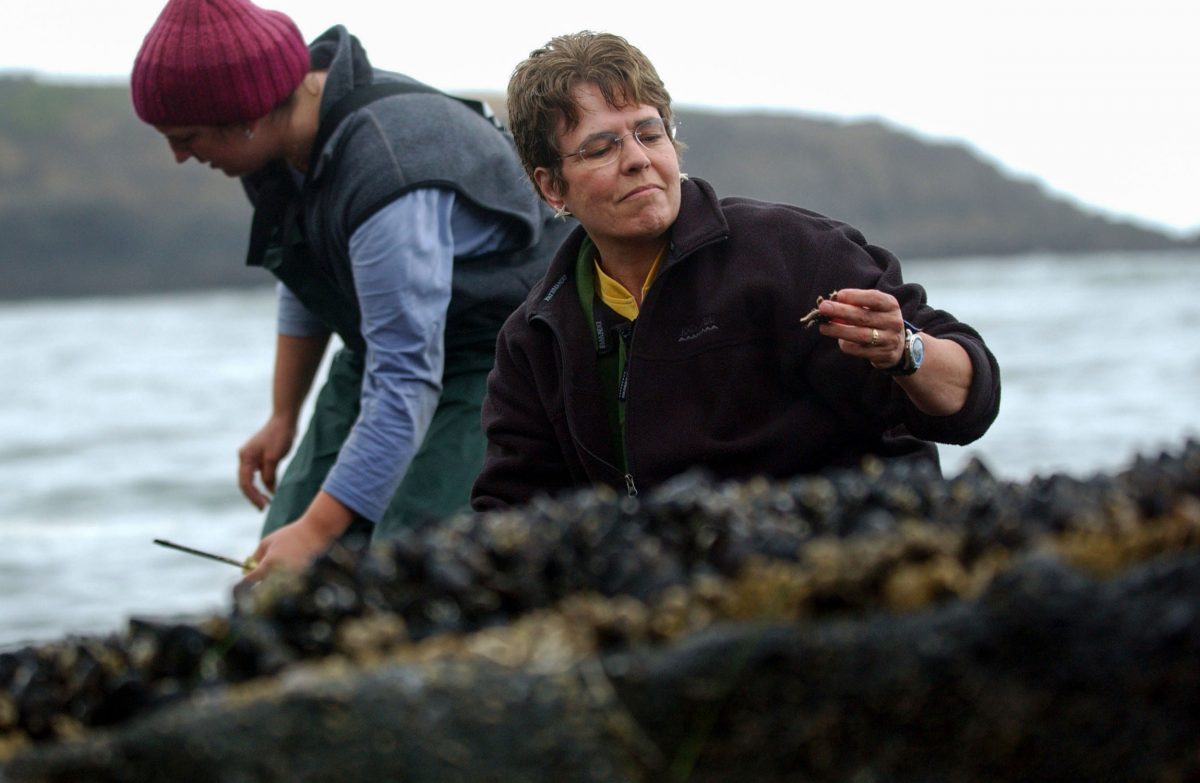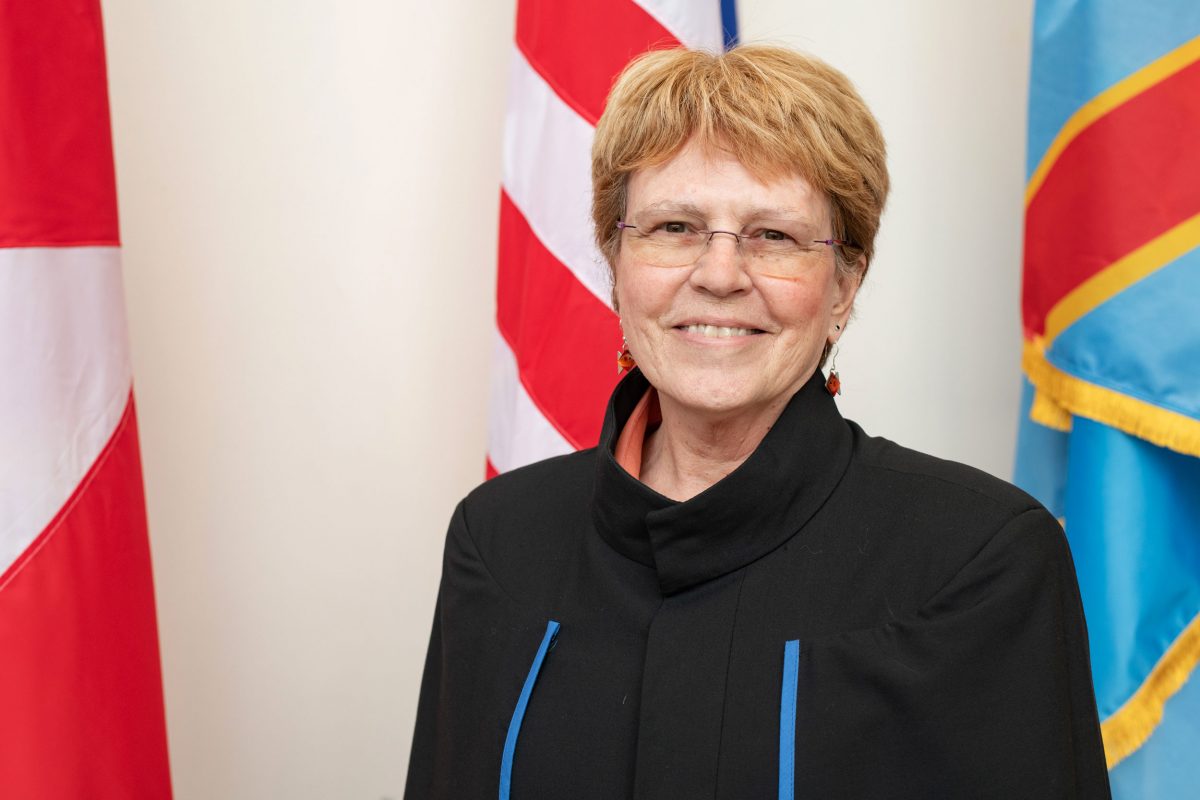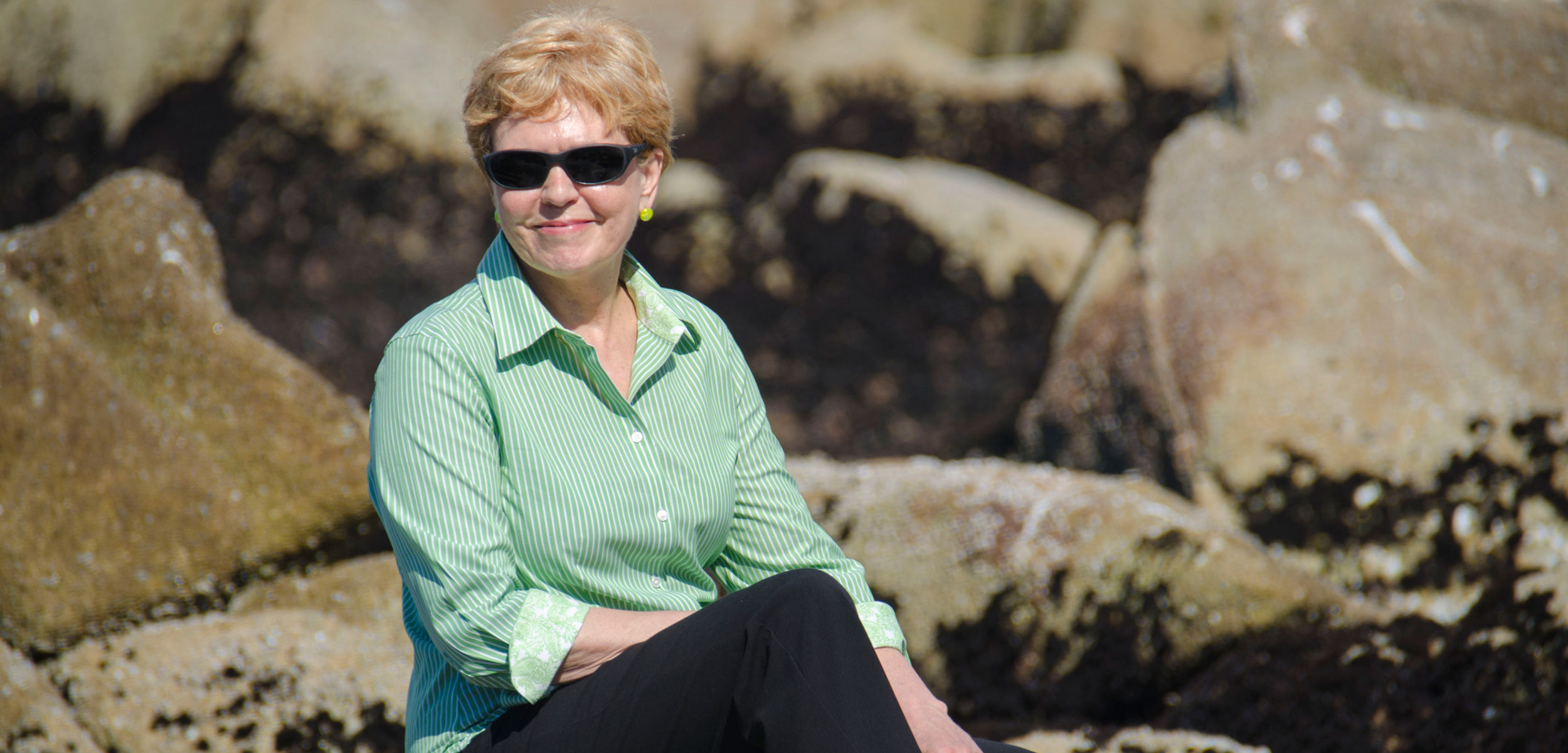An Ecologist Organizes the World
Jane Lubchenco helped change the field of ecology by making the science useful to society.
Article body copy
Back in the mid-1970s, before Jane Lubchenco was a highly cited ecologist, she was climbing around the rocks of New England’s seashore, figuring out why different seaweeds lived in different intertidal zones. One seaweed, called Chondrus (or Irish moss, although it’s not a moss), always lives in the shore’s lower zones. Another one, called Fucus (or rockweed), always lives in zones higher up. Classical ecology would have told her those species were best suited to those locations. But Lubchenco decided to experiment, to remove Chondrus and see if Fucus stayed in its own zone.
Chondrus was hard to remove: it has a crusty part with filaments that reach down into the rock. “Scraping and scraping didn’t work,” Lubchenco says. So she tried a propane torch, which didn’t work either. Then she tried an oxyacetylene torch, a kind of metal-cutting flamethrower. Regardless of the method, Chondrus either wouldn’t go away or if it did, it came back. Finally, she abandoned finesse and rented a sandblaster, carted it—plus bags of sand and a compressor—out to the shore, put on a protective suit, and blasted a precise 1.5-meter square of Chondrus off the rocks. “And lo and behold,” she says, within several months Fucus had settled happily in the newly opened low zone.
“The low zone is actually a better habitat for Fucus,” she says, “but it is aced out of that prime location by Chondrus, who is really good at hogging space.” That is, seaweed species looking for a place on a rock might consider not only the location but also the competition. And an ecologist with questions might consider not only experimentation but also never giving up.
At the time, experimental ecology was maybe 10 years old but was already showing what classical ecology, older and more descriptive, could not: that the general principles for the behavior of ecosystems could be tested. Lubchenco, working with her colleague and husband, Bruce Menge, added animals—snails, sea stars, and mussels, either predators or competitors—to the Fucus/Chondrus plant equation and showed how predation worked with competition to shape the intertidal ecosystem. Their paper “made quite a splash,” she says, and in 1979 won the George Mercer Award from the Ecological Society of America (ESA) for the best paper by a young researcher.
The Mercer Award in turn led her to ESA’s annual conferences—by now she was an assistant professor at Oregon State University (OSU)—where, at a business meeting, she made suggestions good enough to put her on a committee which she ended up chairing. Her career went from sandblasting rocks to a series of increasingly important positions, the most public of which was undersecretary of commerce for oceans and atmosphere and administrator of the US National Oceanic and Atmospheric Administration (NOAA). She is now Oregon State’s Honorable Jane Lubchenco, University Distinguished Professor, and Wayne and Gladys Valley Professor of Marine Biology. How did she do that? She shrugs and doesn’t elaborate: “One thing led to another.”

Jane Lubchenco studies the intertidal zone in Depoe Bay, Oregon, in 2003. She began her career in the 1970s, researching seaweeds in New England, before moving to the west coast for a position at Oregon State University. Photo by Sol Neelman/Zumapress.com
The main “thing” was a then-unusual scientific taste for usefulness. Like many scientists, ecologists highly valued pure science, that is research guided more by curiosity than by society’s needs. Lubchenco never stopped doing pure science, but at some point, her career veered into the socially relevant. She’s written widely read papers urging ecologists to consider their social usefulness, scientists to consider their social contract with society, and humans to consider their wholesale alteration of the planet. She didn’t leave it at urging awareness and change, she went on to co-create programs to make them happen. A colleague, Peter Kareiva at the University of California, Los Angeles, says Lubchenco’s career was shaped by an attitude of “we gotta do something about it.”
Lubchenco sees her career as the result of her training as an ecologist who went from studying internal connections within nature’s ecosystems to the larger network that connects nature with people, as though nature and people were all one ecosystem. “Ecologists,” she says, “see connections.”
Jane Lubchenco manages to be confident and calm while also being high-energy and overbooked. She’s got sandy-colored hair, always worn short, and a friendly but disconcertingly direct look. She’s the eldest of six athletically competitive sisters—“We were jocks,” she says—and unfashionably won most arm-wrestling contests. She was raised in landlocked Colorado, but when she was an undergraduate at Colorado College, she took a field class about the invertebrates living on the east coast’s rocky seashores and a new world opened: “Oh, my gosh,” she thought, “so many different ways of making a living, of eating and finding mates. I really want to be doing something with the ocean.”
Then she took her first ecology class. She was bored. Ecologists in the late 1960s observed patterns and assumed causes: the habitat in which a creature lives, for example, was assumed to be that to which it’s best suited. Lubchenco was unimpressed. “Eh, this is all obvious,” she thought. The science might be legitimate but it was incomplete.
Time passed. In her graduate program in vertebrate physiology at the University of Washington, she met the “dynamic, helpful, argumentative” students of Robert Paine, an ecologist in the process of moving the field toward the experimental. That is, to understand how a predator influences an ecosystem, remove the predator and watch what happens to the system. When Paine and his group removed predator sea stars, the number of mussels increased so much they outcompeted other species for space and the result was a mussel barrens—nothing living in the area except mussels. In short, the whole house that Jack built was being governed by sea stars, which Paine called the keystone species. “This is not the ecology I knew,” Lubchenco thought. “This is cool. It was searching not only for patterns but for their causes.”
So she switched to ecology and went on to get a doctorate in 1975 at Harvard University in Massachusetts, working in particular on the lives and fortunes of Fucus and Chondrus, of seaweeds and their predators. Later, she moved to OSU and, either singly or with Menge, continued studying the creatures living on rocky seashores, finding similar principles of predation and competition echoed in other ecosystems. For example, sea otters eat sea urchins; remove the otters, and the urchins multiply and eat all the kelp and, she says, “you’ve turned a lush kelp forest with hundreds of species into a weedy wasteland.” Her early research underpinned her later work, she says. “It gave me insight into how ecosystems work.” That is, how the success or failure of one thing affects the success or failure of another and finally changes the entire landscape.

Lubchenco has witnessed the decimation of coral reefs in real time over the course of her career. In 2010, she joined a National Oceanic and Atmospheric Administration (NOAA) coral restoration project in Florida. Photo courtesy of Oregon State University
Then in 1988, Frank Press, the president of the National Academy of Sciences, declared one of science’s perennial truths: given that funding for science is limited and supplied mostly by the government, which also decides which research to fund, scientists who need funding would be advised to weigh in on government decisions. By this time, Lubchenco was vice president of the ESA and she and the president, Harold Mooney, now retired from Stanford University in California, conferred with colleagues and decided the best way for ecology to improve its funding—which was then “pitiful,” Lubchenco says—was to show its relevance to society.
But ecologists, dedicated to pure research as they were, weren’t used to considering relevance. “[They] clearly found it very challenging to explain their societal importance,” writes Sharon Kingsland, a historian of ecology at Johns Hopkins University in Maryland. Lubchenco and an ESA committee, after weighing pure research versus socially useful research, decided to recommend both—a “brilliant synthesis,” Mooney said. The resulting report, The Sustainable Biosphere Initiative (SBI), published in 1991, argued that ecologists’ scientific priorities should include what we might now think of as environmental activists’ issues: the ecological causes and consequences of global change, biological diversity, and sustainability. The ideas of the SBI, says Mooney, “went global fairly quickly,” and, says Lubchenco, are “now taken for granted by ecologists: of course science serves society.” Kareiva says it “set the [new] agenda and pretty much profoundly changed the field.”
With the success of the SBI, Lubchenco’s career began a long swerve out of pure science. Part of the reason for the change was an apparent talent for speaking—she doesn’t raise her voice or use emotional language but she stirs up her listeners. The talent is allied with one for leadership. “It is possible to train leaders,” says Pamela Matson, an ecologist at Stanford University and coauthor of the SBI, but “I believe Jane had most of those characteristics inborn.” Between 1992 and 2006, Lubchenco was president of the ESA and the American Association for the Advancement of Science, twice a member of the National Science Board, which governs the National Science Foundation, and made a MacArthur Fellow and a member of the National Academy of Sciences.
Another reason for the swerve was that as the SBI’s emphasis on relevant research implied, Lubchenco thought ecologists needed not only to do useful research but also to tell people what they did and why it was important. In 1998, Lubchenco wrote in Science that the health of ecological systems was crucial to national security, social justice, the economy, and human health, and that along with scientists’ research came a contract with society, a responsibility to communicate what they’d learned about Earth’s large, fast changes.
A third reason for her evolution was the impact of humans on ecosystems: “Places I’d studied and taught,” she says, “were changing, almost before my eyes.” She’d gone diving on the north shore of Jamaica, where, 20 years before, she’d seen spectacular coral reefs. But now—what with a hurricane, sediment from deforestation, chronic overfishing, and the resulting overgrowth of algae—the reefs had become a heartbreaking sight. She cried into her scuba mask. “The place was a wasteland,” she says. She and her colleagues wrote in Science that “human-dominated ecosystems,” which once meant farms or cities, now referred to the whole Earth. The idea had been kicking around for over a century—though the word Anthropocene wasn’t invented until 2000—but Kingsland says the paper caught the public’s growing awareness of both human impact and climate change, and has since become the go-to citation for human domination.
Talking about ideas is easy, but Lubchenco’s career swerve was fundamentally due to a taste for not only talking about ideas but for also acting on them. Lubchenco has three messages: that ecology should pay attention to its social relevance, that ecological systems are most affected by humans, and that ecologists need to talk to people and advise on policy. And she went beyond publishing her messages to co-creating organizations to carry them out. COMPASS primarily trains scientists to explain their research clearly and effectively to the media and policymakers; Climate Central is a collaboration between media and scientists to ensure the public gets reliable, factual information about climate change; and the Leopold Leadership Program funds its scientist-fellows to understand the worlds of the public and policymakers with whom they wish to communicate. Kareiva says ecologists are now routinely entering the public square and “if it weren’t for Jane, that wouldn’t be happening.”
So in 2008, when the newly elected Barack Obama administration needed someone to head NOAA—a job requiring leadership, an understanding of science, and an ability to communicate—Lubchenco was a natural choice. “I think Jane would have been on most short lists for the NOAA job,” says John Holdren, at the Harvard Kennedy School, who worked with her as the administration’s new science adviser.

When former US President Barack Obama was searching for someone to lead NOAA, Lubchenco was an obvious choice. Photo by WDC Photos/Alamy Stock Photo
She had a full plate, including a plan to unite warring constituencies in acceptance of a single policy for managing the oceans and making fisheries sustainable and a fix for a not-yet-launched multibillion-dollar system of Earth-observing satellites that was behind schedule and over budget. She wanted very much to establish an analog to the National Weather Service called the National Climate Service, which would forecast long-term temperatures, droughts, and floods, but her plan fell victim to the buzz saw of legislative-versus-executive-branch politics. All this, she says, “despite the fact that we had coming in over the transom just one major disaster after another.” Between 2009 and 2012, as NOAA’s leader, Lubchenco was responsible for managing the effects of 70 hurricanes and tropical storms (including Irene and Sandy), 770 major tornadoes, six major floods, three tsunamis (including the Tōhoku tsunami), plus wildfires, droughts, and record-breaking snowstorms, as well as “Climategate,” the anthropogenic political and media circus about emails stolen from climate scientists that seemed to show—but did not—a scientific conspiracy to manipulate climate data.
Arguably the most important, or at least the longest-lasting, disaster Lubchenco helped manage was the Deepwater Horizon oil spill. On April 20, 2010, an explosion on the BP oil rig killed 11 people and spilled more than 507 million liters of oil into the Gulf of Mexico in the three months before the oil well was capped. The problems were urgent and complex: how to measure the rate of flow, how to stop the flow, what to do with the oil, how to protect the marine wildlife, whether to close fisheries. Responsibilities for the solutions were spread among various private and government entities, not all of whom talked to each other. “And in the fog of war,” Lubchenco says, “nobody knew how bad it was.”
NOAA was in charge of figuring out the spill’s impact on the ocean and fisheries. And between NOAA’s measurements, BP’s challenges of government measurements, differing measurements by independent scientists talking to the media, and congressional demands, it was, for a while, a hydra-headed mess. “It was a comedy of errors that wasn’t comedic,” Lubchenco says. After the oil well was finally capped, the oil was gradually cleaned up or dispersed, the seafood was tested and found to be safe, and various investigations and reports were completed, Lubchenco wrote a lessons learned report about how to negotiate the science, politics, public concerns, and media coverage in the next crisis. Kathryn Sullivan, Lubchenco’s successor at NOAA, says the extent to which NOAA came out of the crisis in good shape was due to Lubchenco’s “standing and scientific acumen and sense of strategy.”
Lubchenco left NOAA in 2013 after four years. Going into the job, she knew that political appointees were important to government. “But I love teaching,” she says, “I love doing research.” So she went back to the west coast, and in addition to resuming an academic career, now serves on a number of panels and organizations, related mostly to her first love, marine ecology. She cochairs, for example, the scientists advising the High Level Panel for a Sustainable Ocean Economy, a group of international heads of state, which recently identified the ways in which the ocean could offset climate changes on the land.

Lauded by many in her field, Lubchenco received an honorary doctorate from the University of Antwerp in Belgium in 2019. Photo by Jonas Roosens/Belga/Newscom
One of her many projects is an ambitious, multi-institutional collaboration between federal and state agencies, territories, tribes, fishery management councils, and conservation groups that manages marine protected areas (MPAs), areas of oceans shielded from various human impacts. Global MPA programs began in the 1980s, but by 2000, only 0.1 percent of the ocean was covered by them. Today, 7.6 percent is protected to some degree; the United Nations has asked that 10 percent be protected by 2020. So far, MPAs work, though they work best if fully protected: depending on the degree of protection, fish are more abundant and their ecosystems are more biodiverse.
Lubchenco thinks the problems of the oceans, like those of the land, are urgent, complicated, and hard to solve. But when she arranges facts into a story, it’s one of hope. “I have personal experience seeing ocean ecosystems recover from intense overfishing,” she says. “I’ve also seen social systems with tipping points [where] public opinion has changed 180 degrees. Both social and ecological systems can change rapidly, and that gives me hope we can fix the problems. It’s a constant dance between urgency and hope.”
In photos of Lubchenco, she’s usually wearing one of various pins: sea star, seahorse, ray, crab, jellyfish, nautilus, you get the idea. She’s in her early 70s now. She chooses not to run any one thing any more, she doesn’t want a single focus on, say, a foundation or a university. Kareiva thinks she’d be bored. And he may be right: “I like to work with a diversity of organizations,” she says, “and broker new connections.”
The fact is, we live and always have lived embedded in connections, in natural networks. “I listen to the coupled natural-human systems to try to figure out not just what nature is telling us, but what society is telling us,” Lubchenco says. “And I try to put those together. So that’s, you know, the way an ecologist thinks about the world.” As though we’re all just Fucus and Chondrus and mussels on a rock, scaled up. We’re all one system.

